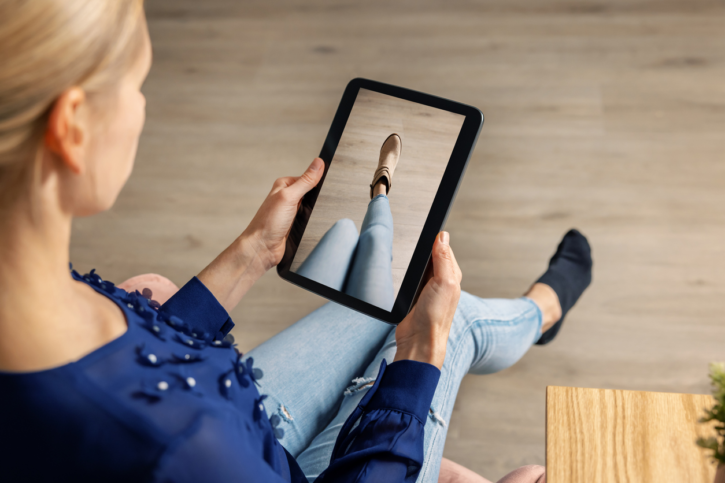E-commerce and augmented reality: good practice
If you were around when the first mobile phones made their appearance, there’s a good chance that you might feel overwhelmed by artificial intelligence, virtual fitting and styling, augmented reality (AR), etc. Even if all these new technologies seem difficult to understand, they represent real business opportunities for e-tailers.
So, without delay, here’s how to make the most of augmented reality in e-commerce.
What is augmented reality?
Augmented reality is an emerging technology that changes the appearance of the real world by layering digital data over it. In other words, AR allows objects from the real and virtual worlds to interact within the same experience.
This technology has existed for a while, as the first augmented reality system was designed in 1968 by Ivan Sutherland. But in the field of e-commerce, it has only been available for a few years.
The use of augmented reality in e-commerce allows customers to:
- try on clothing, glasses and make-up virtually
- make a product appear in front of them without it being really there (e.g. a vase on a table)
- film themselves or take a photo of themselves with objects in the background (e.g. a giant perfume bottle in the sky for an advertising campaign), etc.
Interesting fact💡
According to Goldman Sachs, between now and 2025, revenues generated by augmented reality and virtual reality in retail are expected to reach 1.6 billion dollars.
How can augmented reality improve your e-commerce site?
Thanks to augmented reality, your clients can access a virtual fitting room. They can try on your products remotely before ordering them!
But that’s not all: here are 4 ways of using augmented reality on your e-commerce site.
1. Virtual fitting and styling
When we love a product on a model, we might order it and try it on. But if it doesn’t suit us, sometimes this can leave us feeling very disappointed.
To avoid your customers feeling this frustration and returning products, you can offer a virtual fitting and styling solution. This technology will help increase your conversion rate because purchasers will know if it suits their body shape or skin tone before they add the product to their basket.
2. Visualisation of a product in a certain location
“What will this sofa look like in my living room?”, “How big will the screen really look on the wall opposite my sofa?”, etc.
Before buying furniture, decorative items or white goods, customers have all sorts of questions… To help them choose, it’s an excellent idea to offer augmented reality.
Thanks to AR, your customers can see in real time what the product would look like when placed in their environment. They can move it around to find the best location.
The example of Houzz
Houzz launched Houzz Pro in 2022: a tool that enables an interior to be visualised before renovation work is carried out. This new AR app allows a 3D guided tour of an interior that doesn’t yet exist, but could become reality. This 2.0 tool greatly helps users to make decisions.
Here’s a preview of this app:

3. Interactive tutorial
When Toyota launched their first interactive user guide in augmented reality on smartphones in 2016, it was a revolution. Thanks to this free app for smartphones and tablets, the Japanese brand’s customers could get familiar with all the dashboard functions.
To access this new-style user manual, customers simply scanned the dashboard on their app. They could then see the data about the various elements and understand their functions.
If you sell a product with various buttons, like a vehicle for example, it may be advantageous to create an interactive user manual. This will help users better understand how your product functions.
4. Filters based on augmented reality
If you have used Instagram Stories or Snapchat recently, you may have seen filters based on augmented reality. Previously, these filters have mostly been for entertainment purposes. Today, more and more brands are using these filters as part of their advertising campaigns.
Here are some benefits of augmented-reality based filters:
- they are an excellent way to present a new product, allowing people to test how it will look on them
- they boost subscriber engagement
- they encourage users to tag you in their content
- they create a “wow” effect that can help you to stand out from the competition on social media
What are the benefits of augmented reality in e-commerce?
Augmented reality (AR) offers some very valuable benefits, as much to e-tailers as to customers.
Here’s what it can do:
- reduce the number of returns
- offer an immersive customer experience
- increase customer engagement and boosts sales
- attract new customers and help you stand out
Examples of augmented reality in e-commerce
Augmented reality at Lancôme

On the Lancôme site, it is possible to test lipstick, mascara and foundation completely virtually.
To do this, users simply have to:
- click on the “try it on” button underneath the product photo
- upload a photo of themselves or use a model’s photo
- admire the result
Augmented reality at IKEA

IKEA has launched IKEA KREATIV: an augmented-reality based tool which can be used to visualise objects in empty or furnished rooms, in different angles.
The Scandinavian brand was one of the first major furniture retailers to introduce augmented reality to its online shop. Applied to the furniture sector, this technology is ideal for designing bespoke living spaces.
Augmented reality at Alain Afflelou

On the Alain Afflelou website, it is possible to try on glasses using your camera, without having to go into a store. This is very practical in terms of saving time and asking for the opinion of friends and family in complete privacy, from the comfort of your own home.
Here’s how to use augmented reality on the eyewear manufacturer’s website:
- find your ideal glasses
- click on the virtual try-on icon
- authorise the use of your webcam
- try them on
Customers can also import a photo of their face to try on a pair of glasses at home if they don’t have a webcam on their computer.
Augmented reality & e-commerce: over to you!
As we enter the new era of augmented reality, it’s essential to get to grips with this subject to stay ahead of your competitors.
Whether you sell make-up, accessories, clothes, glasses, cars or furniture, you have everything to gain by integrating augmented reality tools into your online shop.
And who knows, perhaps this technology will soon allow us to smell perfumes or taste food? 🍳
Want to stand out from the crowd?
Here are some ways to stand out from the competition in e-commerce.






